管理经济学ManagerialEconomics12
- 格式:pptx
- 大小:224.76 KB
- 文档页数:42
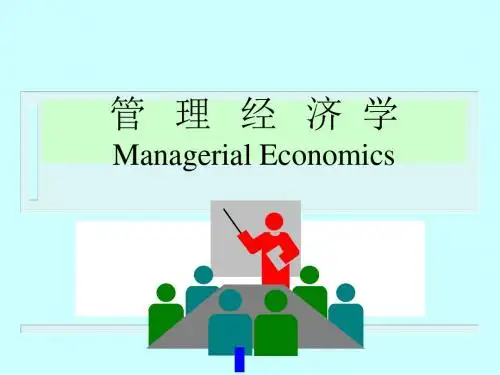

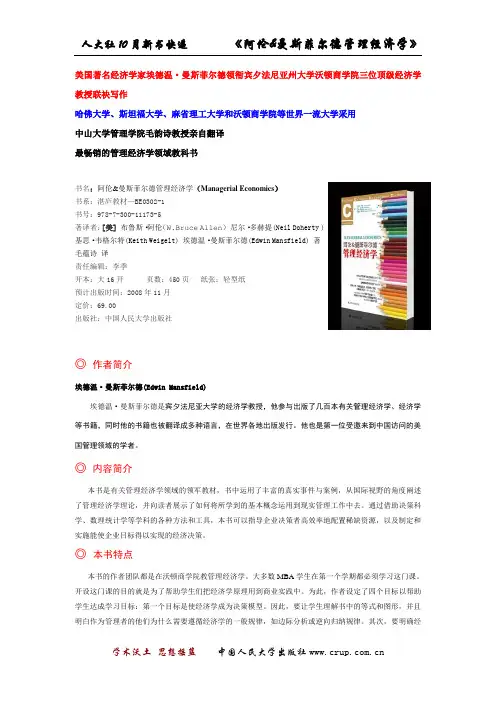
美国著名经济学家埃德温·曼斯菲尔德领衔宾夕法尼亚州大学沃顿商学院三位顶级经济学教授联袂写作哈佛大学、斯坦福大学、麻省理工大学和沃顿商学院等世界一流大学采用中山大学管理学院毛韵诗教授亲自翻译最畅销的管理经济学领域教科书书名:阿伦&曼斯菲尔德管理经济学(Managerial Economics)书系:湛庐教材—BE0302-1书号:978-7-300-11173-5著译者:[美]布鲁斯·阿伦(W.Bruce Allen)尼尔·多赫提(Neil Doherty )基思·韦格尔特(Keith Weigelt) 埃德温·曼斯菲尔德(Edwin Mansfield) 著毛蕴诗译责任编辑:李季开本:大16开页数:450页纸张:轻型纸预计出版时间:2008年11月定价:69.00出版社:中国人民大学出版社◎作者简介埃德温·曼斯菲尔德(Edwin Mansfield)埃德温·曼斯菲尔德是宾夕法尼亚大学的经济学教授,他参与出版了几百本有关管理经济学、经济学等书籍,同时他的书籍也被翻译成多种语言,在世界各地出版发行。
他也是第一位受邀来到中国访问的美国管理领域的学者。
◎内容简介本书是有关管理经济学领域的领军教材,书中运用了丰富的真实事件与案例,从国际视野的角度阐述了管理经济学理论,并向读者展示了如何将所学到的基本概念运用到现实管理工作中去。
通过借助决策科学、数理统计学等学科的各种方法和工具,本书可以指导企业决策者高效率地配置稀缺资源,以及制定和实施能使企业目标得以实现的经济决策。
◎本书特点本书的作者团队都是在沃顿商学院教管理经济学。
大多数MBA学生在第一个学期都必须学习这门课。
开设这门课的目的就是为了帮助学生们把经济学原理用到商业实践中。
为此,作者设定了四个目标以帮助学生达成学习目标:第一个目标是使经济学成为决策模型。
因此,要让学生理解书中的等式和图形,并且明白作为管理者的他们为什么需要遵循经济学的一般规律,如边际分析或逆向归纳规律。
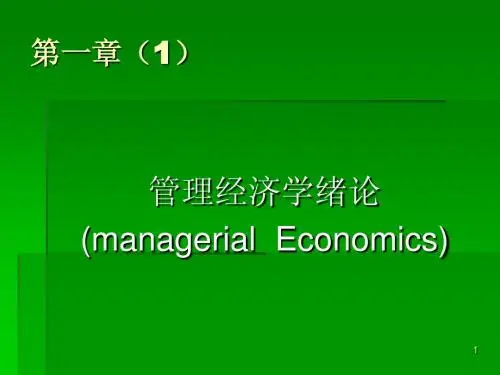
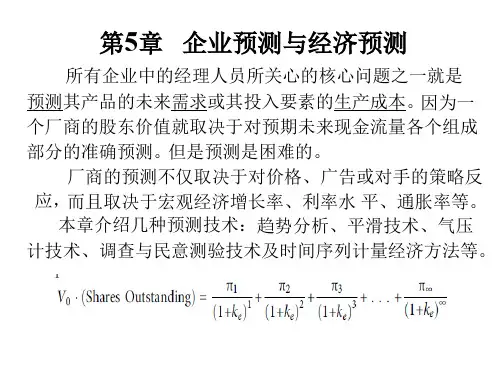

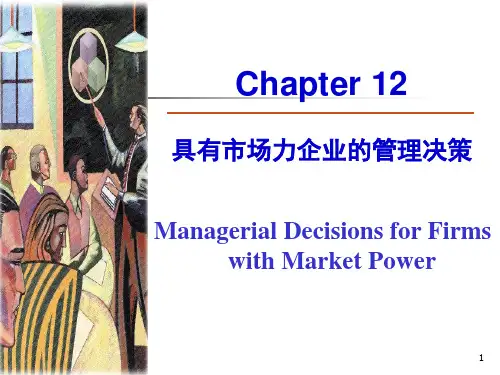
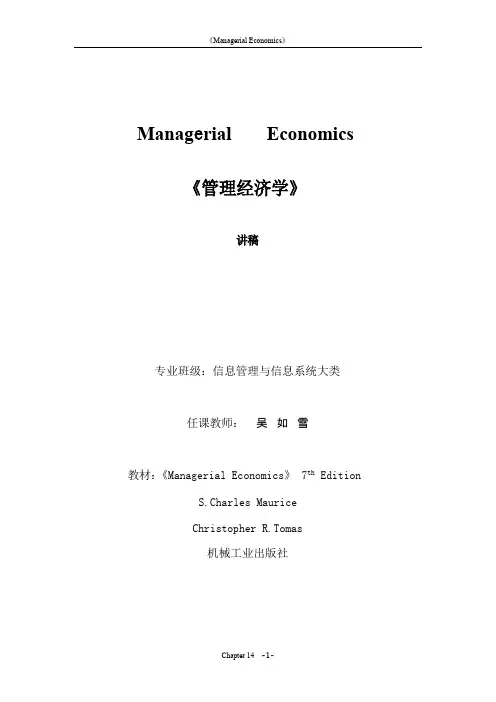
Manag e rial Economics《管理经济学》讲稿专业班级:信息管理与信息系统大类任课教师:吴如雪教材:《Managerial Economics》7th EditionS.Charles MauriceChristopher R.Tomas机械工业出版社CHAP14.Strategic Decision Making in Oligopoly Markets14.1Characteristics of oligopoly●Oligopoly is a market structure in which only a few sellers offer similar or identical products.It consists of a few relatively large firms,each with a substantial share of the market and all recognize their mutual interdependence.Mutual interdependence means that the actions of any one firm in the market will have an effect on the sales and revenues of other firms.Each firm knows that its actions or changes will have such an effect and that the other firms will,in response,take actions or make changes that will affect its sales.But no firm is really sure how the other firms will react—there is an uncertainty about the reaction of rivals to a price change.Common characteristics:(1)The number of firms in an oljgopoly market is small enough that each firm recognizes its mutual interdependence with the other firms.(2)All oligopolies have a certain amount of market power.If an oligopolist raises its price,it generally won’t lose all its sales;if it lowers its price,it won’t gain the entire market.(3)Oligopoly markets are characterized by some barriers to entry,ranging frommoderate to high.Differing characteristics:(1)Oligopolies can be classified by the type of product produced.In some oligopoly markets the products are homogeneous.Other oligopolymarkets are characterized by differentiated products.(2)Oligopolies can be Cooperativeor noncooperative:Cooperative oligopolists tend to follow changes made by rival firms.Noncooperative oligopolists,on the other hand,do not accommodate such changes.(3)Some oligopolistic market are characterized by a great deal of price competition.Inothers,firms don’t compete extensively by price changes but instead compete with theiradvertising,product quality,and marketing strategies.Four general oligopolistic market structures:(1)A few noncooperative firms producinga homogeneous product,(2)A few noncooperative firms producing related butdifferentiated products,(3)A few cooperative firms producing a homogeneous product,(4)A few cooperative firms producing related but differentiated products.Becauseoligopoly markets differ so greatly in their behavior patterns and in their overallcharacteristic,economists have not been able to develop a single general theory ofoligopoly,unlike the case for the other three market structures we have analyzed.●The problem with oligopoly demand:In spite of the uncertainty of rivals to a price change,managers of oligopolies should use the marginal revenue—marginal cost rule when making decisions.This is one of the most important rules of decision making,even when the market is characterized by uncertainty about the reaction of rivals.The problem for an oligopolist is accurately forecasting its demand and marginal revenue if it changes its price.Any change in price and output has a noticeable effect on the sales of other firms.These rivals may react by changing their prices and output,or they may not react at all.In our discussion of oligopoly markets,we will emphasize that the price and output decisions depend critically upon the assumptions made about the behavioral reactions of rival managers.Since many different assumptions can and have been made,many different solutions can and have been reached. 14.2Decision making when rivals make simultaneous decisionsOligopolists are mutual interdependence.Mutual interdependence requires strategic behavior.We can’t give a set of rules to follow.The art of making strategic decisions is learned from experience.We can,however,introduce a tool for thinking about strategic decision making.●Game theory provides a useful guideline on how to behave in strategic situations involvinginterdependence.This theory was developed approximately50years ago in order to provide a systematic approach to strategic decision making.A game is any decision-making situation where people compete with each other for thepurpose of gaining the greatest individual payoff,rather than group payoff,from playingthe game.In the game of oligopoly,the people in the game,often called“players”,aremanagers of the oligopoly firm.Payoffs in the oligopoly game are the individual profitsearned by each firm.Simultaneous decision games occur in oligopoly markets when managers must make their individual decisions without knowing the decisions of their rivals.Decisions don’thave to take place at the same time in order to be“simultaneous”.●The prisoner’s dilemma—a widely known game of simultaneous decision makingThe story(page533)Payoff table is a table showing,for every possible combination of decisions players canPayoff table:Bill Don’t confess Confess Common knowledge is a situation in which all decision makers know the payoff table,Payoff table:Palace’s price High($10) Low ($6) Pizza Palace has a dominant strategy: price low at $6. Pizza Castle does not have a dominant make, the outcomes or “payoffs” for each of the players in each decision combination.Jones Don’t confessConfess and they believe all other decision makers also know the payoff table. This common knowledge of the payoff table plays a crucial role in determining the outcome of a simultaneous decision game.A dominant strategy in a game theory is a strategy or action that always provides thebest outcome no matter what decisions rivals make. The prisoner’s dilemma illustrates a way of predicting the likely outcome of a strategic game using the concept of a dominant strategy. In the prisoner’s dilemma, confessing is a dominant strategy for each suspect.When a dominant strategy exists, a rational decision maker always chooses to follow its own dominant strategy and predicts that if its rivals have dominant strategy, they also will choose to follow their dominant strategy.The outcome of a game in which both players have dominant strategies and play them iscalled a dominant-strategy equilibrium. When all decision makers have dominant strategies (and know their dominant strategies), managers will be able to predict the actions of their rivals with a great deal of certainty.Most strategic situations, in contrast to the prisoner’s dilemma game, do not have a dominant-strategy equilibrium.● Decisions with one dominant strategyAn example of Pizza Castle and Pizza PalaceCastle’s price High($10)Low ($6) strategyWhen a firm does not have a dominant strategy, but at least one of its rivals does have adominant strategy,the firm’s manager can predict with confidence that its rivals willfollow their dominant strategies.Then,the manager can choose its own best strategy,knowing the actions that will almost certainly be taken by those rivals possessingdominant strategies.Knowing that Palace’s manager will rationally choose to set price low at$6,Castle’s manager will likely decided to price high at$10(and give away soft drinks).●Successive elimination of dominated strategies:When deciding what to do in a simultaneousdecision situation,managers should eliminate from consideration dominated strategies.Dominated strategies are strategies that would never be chosen because at least one other strategy provides a higher payoff no matter what rivals choose to do.Successive elimination of dominated strategies is an iterative decision-making process in which managers first eliminate all dominated strategies in the original payoff table.Eliminating dominated strategies always simplifies a decision-making problem.In a simultaneous decision having no dominant strategy equilibrium,managers can simplify their decisions by eliminating all dominated strategies that may exist.The process of elimination should be repeated until no more dominated strategies turn up.Strategically astute managers always search first for dominant strategies,and,if no dominant strategies can be discovered,they next look for dominated strategies.Unfortunately, simultaneous decision frequently fail to provide managers with either dominant or dominated strategies.●Nash equilibrium:Making mutually best decisions(will be introduced in OR)In the absence of any form of strategic dominance,managers must use a different,but related, guiding concept for making simultaneous decisions.This concept,known as Nash equilibrium, can sometimes,but not always,guide managers in making simultaneous decisions.In order for all firms in an oligopoly market to be predicting correctly each other’s decision,all firms must to be choosing individually best actions given the predictedactions of their rivals.It follows,then,that strategically astute managers will search thepayoff table for mutually best decisions:cells in the payoff table in which all managersare doing the best they can given their beliefs about the other managers’actions.Nash equilibrium is a set of actions for which all managers are choosing their bestPepsi’s budgetLow Medium High (Payoffs in millions of dollars of semiannual profit)actions given the actions chosen by their rivals.Strategic stability: Since all decisions are mutually best decisions in Nash equilibrium,no single firm can unilaterally make a different decision and do better. This property or condition of Nash equilibrium is known as strategic stability , and it provides thefundamental reason for believing that strategic decision makers will likely decide on a Nash pair of decisions.An example of Nash equilibrium: Super Bowl Advertising (P543-545)LowCoke’s budget MediumHigh Neither Pepsi nor Coke has a dominant strategy or dominated strategy. The only Nash equilibrium is (High , High).When managers face a simultaneous decision-making situation possessing a unique Nash equilibrium set of decisions, rivals can be expected to make the decisions leading to the Nash equilibrium. If there are multiple Nash equilibria, there is generally no way to predict the likely outcome.● Best-response curves and continuous decision choicesIn many decisions, actions or strategies are continuous decision variables. Whenmanagers make pricing decisions, they seldom view the choices as being either ”low” or “high” prices. In stead they choose the best price from a continuous range of prices. Best-response curves is a tool to analyze and explain simultaneous decisions when decision choices are continuous rather discrete. Best-response curves give managers the profit-maximizing price to set given the price they anticipate their rival will set.An example: P548-552. The following demand curves is common knowledge:Q A = 4000 - 25 p A + 12 p B , Q B = 3000 - 20 p B + 10 p AThus, p A = 160 - 0.04Q A + 0.48 p B , p B = 150 - 0.05Q B + 0.5 p AMR A = 160 - 0.08Q A + 0.48 p B , MR B = 150 - 0.1Q B + 0.5 p A,212=A p 218=B pLet MR A = MC A = 160 and MR B = MC B = 180 , then we have two best-response curves:p A = 160 + 0.24 p B , p B = 165 + 0.25 p AA Nash equilibrium occurs at the price pair where the firms’ best-response curves intersect:* * 14.3 Strategy when rivals make sequential decisions● Sequential decisions —decisions in which one firm makes its decision first, then a rival firmmakes its decision. Even though they are made at different times, sequential decisions involve strategic interdependence. Strategically astute managers must think ahead to anticipate their rival’s future decisions. Current decisions are based on what manager believes rivals will likely do in the future.● Making sequential decisions: we use game trees to analyze sequential decisions.A game tree is a diagram showing the structure and payoff of a sequential decisionsituation. It has decision nodes with branches extending from the nodes.✧ Decision nodes —points in a game tree, represented by boxes, where decisions aremade.✧ A game tree usually proceeds from left to right along branches until final payoffsassociated with each decision path are reached.(Figure 14.3: a game tree —Castle go first)Roll-back method (backward induction)—method of finding a Nash solution to asequential decision by looking ahead to future decisions to reason back to the best current decision. When firms making sequential decisions, managers make best decisions for themselves using roll-back method. The roll-back method results in a unique path that is a Nash decision path: each firm does the best for itself given the best decisions made by its rivals.● First-mover and second-mover advantageThe outcomes of some sequential decisions depend on which firm makes its decision first and which firm goes second.First-mover advantage —Sometimes a firm can increase its payoff by making itsdecision first.Second-mover advantage—Sometimes a firm can increase its payoff by letting its rivals make the decision first.How can we tell whether a sequential decision has a first-mover advantage or a second-mover advantage,or neither type of advantage?The simplest way,and frequently theonly way,is to find the roll-back solution for both sequences.If the payoff increases bybeing the first(second)to move,then a first-mover(second-mover)advantage exists.Ifthe payoffs are identical,then order of play confers no advantage.It is difficult to determine which firm goes first(second)when both firms recognize that going first(second)confers a first-mover(second-mover)advantage.●Strategic moves:commitments,threats,and promisesThere are three kinds of actions that firm might employ to alter the structure of a game to their advantage:commitments,threats,and promises.Commitments—Unconditional strategic moves taken for the purpose of increasing payoffs to the committing firm.Managers make commitments by announcing,ordemonstrating to rivals in some other way,that they will bind themselves to take aparticular action or make a specific decision no matter what action or decision istaken by its rivals.An example:P557Figure14.4.Motorola seizes the first–mover advantage an ensure its outcome in cell A by building a facility in Brazil specifically designed for manufacturing and serving only analog phones.Threats—Conditional strategic moves that take the form:”If you do A,I will do B, which is costly to you.”The purpose of making threats is to manipulate rivals’beliefsabout the likely behavior of the threatening firms in a way that increases payoffs to thethreatening firms.Promises—Conditional strategic moves that take the form:”If you do A,I will do B, which is desirable to you.”These three strategic moves must be made before rivals have made their decisions.They may be utilized separately or in combination with each other.Strategic moves will achieve their desired effects only if rivals think the firms making the moves will actually carry out their commitments, threats,or promises.Only credible strategic moves matter.Rivals will ignore strategic moves thatare not credible.14.4Strategic entry deterrence●Strategic entry deterrence:Managers of firms in oligopoly markets sometimes use differenttypes of strategic behavior to prevent new rival firms from competing with them.Strategic entry deterrence occurs when an established firm(or firms)makes strategic moves designed to discourage or even prevent the entry of a new firm or firms into a market.Limit pricing:Under certain circumstance an oligopolist,or possibly a monopolist,may charge a price lower than the short-run profit-maximizing price in order to prevent ordiscourage new firms from entering the market.Such a strategy is called entry limitpricing.In order to practice ertry limit pricing,an established firm must have a costadvantage over potential entrants into the market.Capacity expansion as a barrier to entry:Under certain circumstance,it is possible for an established firm to discourage the entry of new firms into the market without actuallydecreasing the price it charges and consequently finding its profits reduced.The firmcan maintain excess capacity,above the capacity it would normally build.The excesscapacity signals to potential entrants that the established firm is prepared to increase itsoutput by reducing its price if new firms prepare to enter the market.●Strategic entry deterrence differs somewhat from the structural barriers to entry discussed inChapter13.Those barriers block entry of new firms by altering a market’s underlying cost or revenue conditions so that a new firm cannot be profitable.Strategic entry deterrence is the result of actions taken by established firms to alter the beliefs potential entrants hold about the behavior of established firms—primarily pricing and output behavior—after they enter.。
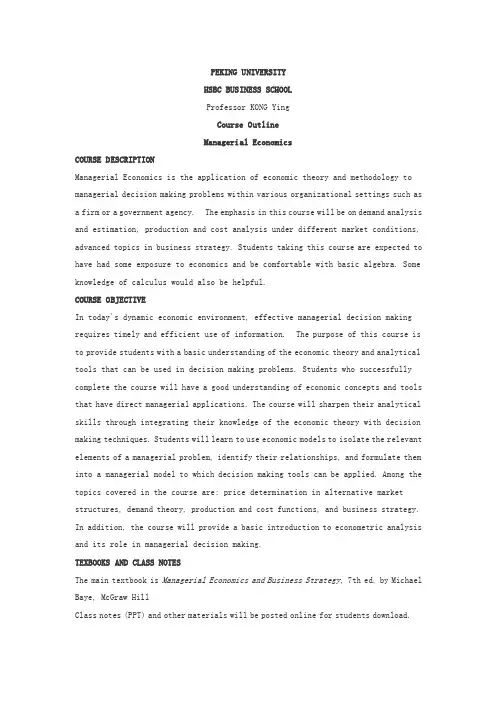
PEKING UNIVERSITYHSBC BUSINESS SCHOOLProfessor KONG YingCourse OutlineManagerial EconomicsCOURSE DESCRIPTIONManagerial Economics is the application of economic theory and methodology to managerial decision making problems within various organizational settings such as a firm or a government agency. The emphasis in this course will be on demand analysis and estimation, production and cost analysis under different market conditions, advanced topics in business strategy. Students taking this course are expected to have had some exposure to economics and be comfortable with basic algebra. Some knowledge of calculus would also be helpful.COURSE OBJECTIVEIn today's dynamic economic environment, effective managerial decision making requires timely and efficient use of information. The purpose of this course is to provide students with a basic understanding of the economic theory and analytical tools that can be used in decision making problems. Students who successfully complete the course will have a good understanding of economic concepts and tools that have direct managerial applications. The course will sharpen their analytical skills through integrating their knowledge of the economic theory with decision making techniques. Students will learn to use economic models to isolate the relevant elements of a managerial problem, identify their relationships, and formulate them into a managerial model to which decision making tools can be applied. Among the topics covered in the course are: price determination in alternative market structures, demand theory, production and cost functions, and business strategy. In addition, the course will provide a basic introduction to econometric analysis and its role in managerial decision making.TEXBOOKS AND CLASS NOTESThe main textbook is Managerial Economics and Business Strategy, 7th ed. by Michael Baye, McGraw HillClass notes (PPT) and other materials will be posted online for students download.COURSE EVELUATIONMidterm Exam: 30%Final Exam: 50% Consulting Projects: 20%SYLLABUSAll chapters listed below refer to the Baye textbook unless otherwise indicated. You are responsible for materials in the Baye text that correspond to the material covered in class. The Baye text should be viewed as a learning aide, NOT as an independent source of examinable material. However, doing questions end of each chapters will greatly help you to prepare exams.Week 1The Fundamentals of Managerial Economics Ch 1Market Forces: Demand and Supply Ch 2Week 2Quantitative Demand Analysis Ch 3The Theory of Individual Behavior Ch 4Week 3The Production Process and Costs Ch 5Week 4The Organization of the Firm Ch 6The Nature of Industry Ch 7Week 5Midterm ExamManaging in Competitive, Monopolistic,Monopolistically Competitive Market Ch 8Week 6Basic Oligopoly Models Ch 9Game Theory: Inside Oligopoly Ch 10Week 7Pricing Strategies for Firms with Market Power Ch 11Week 8The Economics of Information Ch 12Advanced Topics in Business Strategy Ch 13Week 9A Manager’s Guide to Government in the Marketplace Ch 14Project Presentation and Hand InFinal Exam (TBD)CONSULTING PROJECTSIn order to help students to build up the managerial economics analysis skill we provide 4 real world consulting projects in the course. Students are required to independently conduct 4 consulting reports regarding to the 4 projects. The exercises require you to apply some of the tools you learned in each chapter covered in the class to make a recommendation based on an actual business scenario. The topics of 4 consulting projects are,·Estimating Industry Demand for Fresh Market Carrots·Estimation and Analysis of Demand for Fast Food Meals·Production Decisions at Harding Silicon Enterprises, Inc.·Pricing and Production Decisions at PoolVac, Inc.Cheating, Plagiarism and Free RiderThe penalties for any form of cheating or plagiarism (whether in exams or project) are severe. Written work submitted must be your own. Any sources of information used in completing your work must be identified. Plagiarized written work will not be accepted and you should be aware that non acceptance of a submission might, in some cases, lead to failure in the course. Since the project is a team work, the final report should identify each student’s contribution. The significant uneven contribution in the work will lead to less mark for the student who made less contribution comparing to his/her team member.。

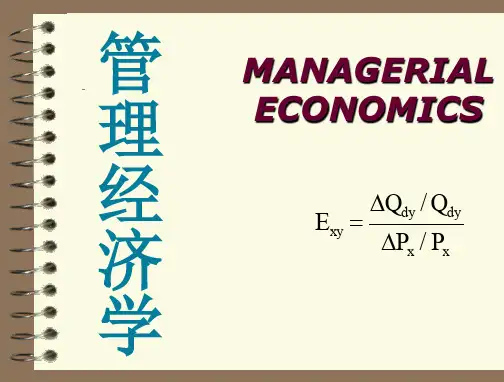
《管理经济学》课程教学大纲目录管理经济学 (1)生产运作管理 (4)数据、模型与决策I (6)数据、模型与决策II (11)人力资源管理 (15)《管理经济学》课程教学大纲课程名称(中文):管理经济学课程名称(英):Managerial Economics学分数: 3学分课内学时:45学时课外自学学时:90学时课程内容简介管理经济学是一门应用微观经济学,是工商管理、会计硕士专业的学位课。
管理经济学主要以微观经济学的基本理论为基础,借助于决策科学的、数理统计学等学科的各种方法和工具,指导企业决策者高效率地配置稀缺资源,制定和实施能使企业目标得以实现的经济决策。
管理自1950年代诞生以来,被国内外越来越多的商学院和管理学院采用为核心必修课程,表明了它在培养造就高水平经济管理人才过程中不可替代的重要作用。
管理经济学的主要内容可分为微观经济理论、统计和优化方法、管理决策等三大部分内容。
按学校国际化的要求,管理经济学授课均采用国际上著名教科书,教学分中文和双语两种方式,双语教学使用英文教材,全英文授课是未来的发展方向。
通过本课程的学习,学员应该对现代市场经济运行机理有全面系统的了解,能用管理经济学的基本理论分析和解决企业所面临的管理问题,掌握企业经营统计、优化的分析工具和方法,熟悉企业常见的经营决策的一般规律和过程,能根据基本的管理经济学原理和具体经营环境,制定出科学的企业决策。
课外自学内容(100字以内,无此项内容的课程不填)为教师重点讲授章节后要求的教科书自学部分,以及发放的课外阅读材料(含案例材料)课程大纲(具体到章、节、小节)1.绪论2.基本训练(选讲内容)3.需求分析4.需求估计(选讲内容)5.企业和经济预测(选讲内容)6.生产理论7.线性规划(选讲内容)8.成本理论9.成本理论应用(选讲内容)10.完全竞争和垄断11.垄断竞争和寡头12.博弈论与竞争战略(选讲内容)13.定价分析与定价方法14.组织形式、治理与机制设计(选讲内容)15.长期投资决策与风险管理(选讲内容)16.技术变革和布点理论(选讲内容)17.企业决策与政府管制(选讲内容)18.专题(任课教师可根据自己的研究作报告)主要参考书目(其中应指定一本作为重点参考教材)1.[美] H·克雷格·彼得森等著。